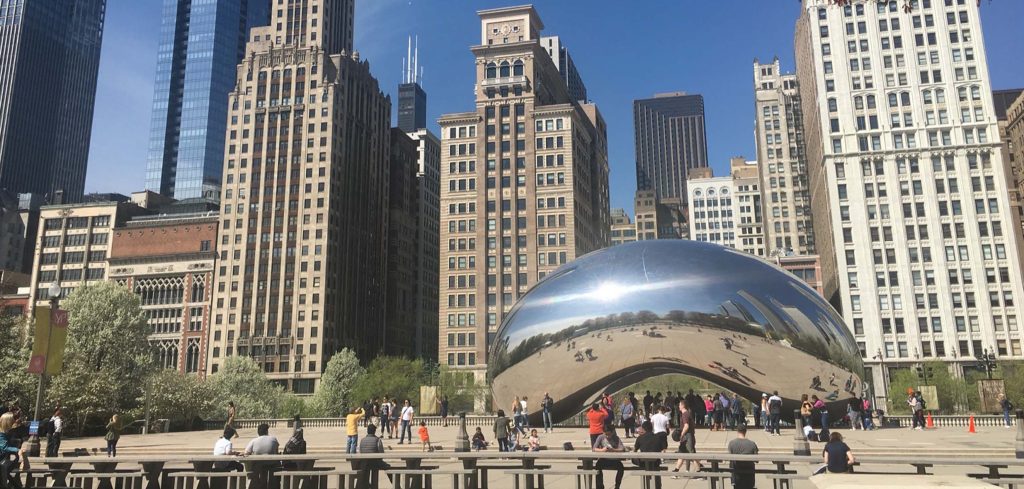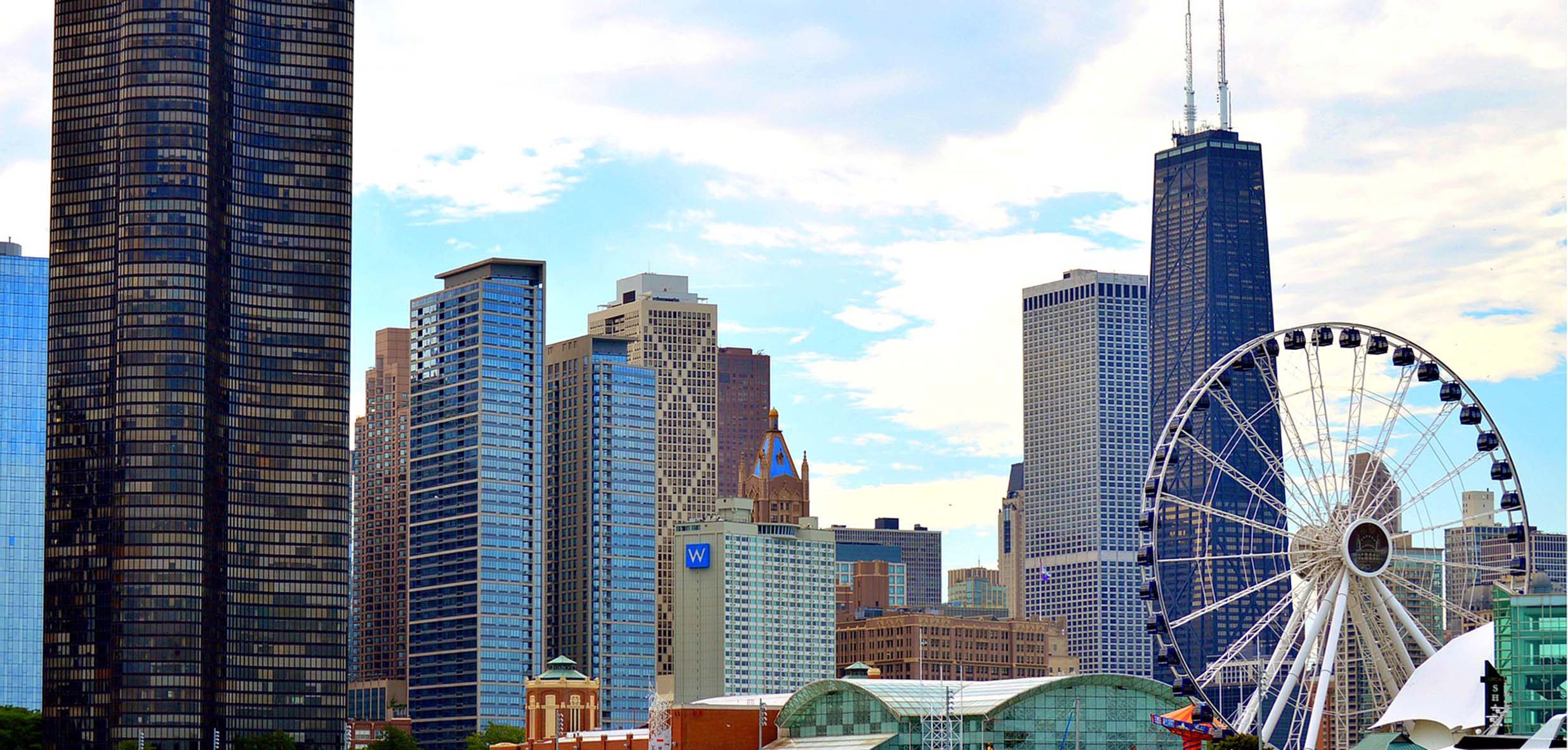Chicago, affectionately known as the Windy City, is a vibrant metropolis that offers a blend of stunning architecture, rich history, diverse culture, and an unbeatable food scene. During my recent trip to Chicago, I set out to explore the city’s iconic landmarks and hidden gems.
1. The Skydeck at Willis Tower: Touching the Sky in Chicago
Location and How to Get There
The Skydeck is located on the 103rd floor of Willis Tower, which is situated at 233 S Wacker Drive in the Loop district of downtown Chicago. Willis Tower, formerly known as the Sears Tower, is one of the most recognizable skyscrapers in the world.
To get to Willis Tower, you can take the CTA (Chicago Transit Authority) train to Quincy Station, which is just a short walk from the tower. Alternatively, several bus routes pass by the building, making it easily accessible from various parts of the city.
The Experience
Standing 1,353 feet above the ground, the Skydeck offers a breathtaking panoramic view of Chicago’s skyline. On a clear day, you can see up to four states: Illinois, Indiana, Wisconsin, and Michigan. The highlight of the visit, however, is stepping out onto The Ledge— a glass box that extends 4.3 feet outside the building, giving you the sensation of floating above the city. It’s both exhilarating and terrifying, especially for those with a fear of heights.
I vividly remember the moment I stepped onto The Ledge. The feeling of standing on glass with the entire city beneath my feet was surreal. Despite the initial nervousness, the view was so mesmerizing that I forgot my fear. The Skydeck also provides interactive exhibits that offer insights into Chicago’s history and its architectural wonders.
Tickets, Discounts, and Booking
Tickets to the Skydeck cost approximately $30 for adults and $22 for children (ages 3-11). You can purchase tickets online through the official Skydeck website, which I recommend to avoid long queues. There are also fast-pass options available for a higher price if you want to skip the lines entirely.
Occasionally, there are discounts available for students, seniors, and military personnel. Additionally, the Chicago CityPASS offers bundled tickets that include access to the Skydeck along with other popular attractions in the city, providing significant savings.
My Personal Recommendation
The Skydeck is a must-visit, especially for first-time visitors to Chicago. The combination of the incredible views, the thrill of The Ledge, and the well-curated exhibits make it a worthwhile experience. I’d rate it a solid 9/10. It’s best to visit on a clear day to get the most out of the views, and if you can, try to time your visit around sunset to witness the city transition from day to night.
2. Millennium Park: The Heart of Chicago’s Cultural Scene
Location and How to Get There
Millennium Park is centrally located in the Loop community area of Chicago, at 201 E Randolph Street. The park is easily accessible by public transportation, with several CTA train and bus lines stopping nearby. The nearest CTA station is Washington/Wabash, just a short walk from the park.

The Experience
Millennium Park is perhaps best known for its public art installations, especially the iconic Cloud Gate, commonly referred to as “The Bean.” This massive, bean-shaped sculpture reflects the city’s skyline and is a popular spot for photos. As I approached The Bean, I was struck by its reflective surface, which perfectly captured the surrounding skyscrapers and the sky above, creating a dynamic piece of art that changes with the weather and time of day.
Another highlight of the park is the Jay Pritzker Pavilion, a striking outdoor concert venue designed by renowned architect Frank Gehry. During my visit, I was lucky enough to catch a free concert as part of the city’s summer music series. The pavilion’s unique design and excellent acoustics made the experience unforgettable.
Millennium Park is also home to the Crown Fountain, two 50-foot glass towers that display the faces of Chicago residents. The fountain is interactive, with water spouting from the mouths of the digital faces, providing a fun and refreshing experience, especially for kids.
Tickets, Discounts, and Booking
One of the best things about Millennium Park is that it’s completely free to enter and explore. This makes it an ideal destination for budget-conscious travelers or those looking to enjoy Chicago’s culture without spending a lot of money. The park often hosts free events, concerts, and exhibitions, so it’s worth checking the schedule on the official Millennium Park website before your visit.
My Personal Recommendation
Millennium Park is a cultural hub and a must-visit for anyone coming to Chicago. The combination of art, architecture, and green space provides a perfect escape from the urban hustle and bustle. I’d give Millennium Park a 10/10, especially if you’re an art lover or simply enjoy spending time outdoors. Be sure to visit early in the morning or later in the evening to avoid the crowds, and don’t forget your camera!
3. The Art Institute of Chicago: A World-Class Art Experience
Location and How to Get There
The Art Institute of Chicago is located at 111 S Michigan Avenue, right in the heart of downtown Chicago. The museum is easily accessible by public transportation, with several CTA bus and train lines stopping nearby. The nearest CTA train station is Adams/Wabash, just a short walk from the museum.
The Experience
The Art Institute of Chicago is one of the oldest and largest art museums in the United States, and it houses an impressive collection of artworks from around the world. From ancient artifacts to contemporary masterpieces, the museum’s extensive collection spans thousands of years of art history.
During my visit, I was particularly drawn to the museum’s collection of Impressionist and Post-Impressionist paintings, which includes iconic works by artists like Claude Monet, Vincent van Gogh, and Georges Seurat. Standing in front of Seurat’s “A Sunday on La Grande Jatte,” I was mesmerized by the intricate pointillism technique and the vibrant colors that brought the scene to life.
Another highlight of the museum is the Thorne Miniature Rooms, a collection of meticulously crafted miniature rooms that offer a glimpse into various historical periods and architectural styles. Each room is a tiny masterpiece, with incredible attention to detail that left me in awe.
Tickets, Discounts, and Booking
General admission to the Art Institute of Chicago is $25 for adults, $19 for seniors and students, and free for children under 14. Illinois residents receive discounted admission, and the museum offers free admission to all visitors on Thursdays from 5:00 PM to 8:00 PM.
Tickets can be purchased online through the museum’s official website, which I recommend to avoid long lines at the entrance. The museum also offers various membership options that provide free admission and other benefits.
My Personal Recommendation
The Art Institute of Chicago is a must-visit for art enthusiasts and anyone with an appreciation for history and culture. The museum’s diverse collection and beautifully curated exhibitions make it a world-class destination. I’d rate it a 10/10 and recommend setting aside at least a few hours to fully explore the museum’s offerings. If you’re short on time, prioritize the Impressionist galleries and the Thorne Miniature Rooms.
4. Navy Pier: Chicago’s Lakeside Playground
Location and How to Get There
Navy Pier is located at 600 E Grand Avenue, extending out into Lake Michigan. The pier is easily accessible by public transportation, with several CTA bus routes stopping directly at the entrance. The nearest CTA train station is Grand/State, and from there, you can take a bus or enjoy a scenic walk to the pier.

The Experience
Navy Pier is a vibrant entertainment hub that offers something for everyone, from family-friendly attractions to cultural events and dining experiences. As I walked along the pier, I was greeted by the sight of the iconic Centennial Wheel, a 200-foot Ferris wheel that offers stunning views of the city and the lake.
I decided to take a ride on the Centennial Wheel, and the experience was nothing short of magical. The panoramic views from the top were breathtaking, with the Chicago skyline on one side and the vast expanse of Lake Michigan on the other. The ride is smooth and lasts about 15 minutes, providing ample time to take in the scenery and snap some photos.
Navy Pier is also home to the Chicago Children’s Museum, a fantastic destination for families with young children. The museum offers interactive exhibits and hands-on activities that are both educational and entertaining. For those interested in the arts, the Chicago Shakespeare Theater, located on the pier, hosts world-class performances in an intimate setting.
In addition to the attractions, Navy Pier boasts a variety of dining options, from casual eateries to upscale restaurants. I opted for a classic Chicago-style hot dog at one of the pier’s food stands, and it did not disappoint. The combination of the all-beef frankfurter, poppy seed bun, mustard, onions, relish, and a pickle spear was a delicious taste of Chicago’s culinary heritage.
Tickets, Discounts, and Booking
Admission to Navy Pier is free, but individual attractions, such as the Centennial Wheel and the Chicago Children’s Museum, have separate ticket prices. A ride on the Centennial Wheel costs about $15 for adults and $12 for children. Combo tickets and passes are also available if you plan to visit multiple attractions on the pier.
It’s a good idea to purchase tickets online in advance, especially during peak tourist seasons, to avoid long lines. You can buy tickets directly from the Navy Pier website or from third-party platforms like TripAdvisor.
My Personal Recommendation
Navy Pier is a must-visit for anyone traveling to Chicago, offering a perfect blend of entertainment, culture, and scenic beauty. Whether you’re looking for a fun day out with family, a romantic evening by the lake, or just a place to relax and enjoy the view, Navy Pier has it all. I’d rate it an 8/10, with the recommendation to visit in the late afternoon and stay through the evening to enjoy the pier’s vibrant atmosphere and the beautiful sunset over Lake Michigan.
5. The Field Museum: A Journey Through Time and Space
Location and How to Get There
The Field Museum is located at 1400 S Lake Shore Drive in Chicago’s Museum Campus, along the shores of Lake Michigan. The museum is easily accessible by public transportation, with several CTA bus routes stopping nearby. The nearest CTA train station is Roosevelt, and from there, it’s a short walk to the museum.
The Experience
The Field Museum is one of the largest natural history museums in the world, and it offers an incredible journey through time, from the age of the dinosaurs to the rise of human civilizations. The museum’s most famous resident is Sue, the largest and most complete T. rex skeleton ever discovered. Standing before Sue, I was struck by the sheer size and power of this ancient predator, and the detailed exhibits provided fascinating insights into the life and times of the dinosaurs.
Another highlight of the museum is the Ancient Egypt exhibit, which features a reconstructed tomb, mummies, and artifacts that offer a glimpse into the lives of the pharaohs and their subjects. The exhibit is both educational and immersive, making it easy to lose yourself in the history of one of the world’s most fascinating civilizations.
The Grainger Hall of Gems is another must-see, showcasing a dazzling collection of rare and beautiful gemstones from around the world. The intricate craftsmanship and the natural beauty of the gems were mesmerizing, and I found myself spending more time in this exhibit than I had anticipated.
Tickets, Discounts, and Booking
General admission to the Field Museum is $26 for adults, $19 for students and seniors, and $18 for children (ages 3-11). The museum also offers all-access passes, which include entry to special exhibits and the 3D theater. Illinois residents receive discounted admission, and there are free admission days for Illinois residents throughout the year.
Tickets can be purchased online through the Field Museum’s official website, which I recommend to avoid long lines, especially on weekends and holidays. The Chicago CityPASS also includes entry to the Field Museum, providing savings if you plan to visit multiple attractions.
My Personal Recommendation
The Field Museum is a treasure trove of knowledge and a must-visit for anyone with an interest in natural history, archaeology, or science. The exhibits are well-curated and engaging, making the museum an excellent destination for visitors of all ages. I’d rate it a 9/10 and recommend allocating at least half a day to fully explore the museum’s offerings. Don’t miss the chance to see Sue up close and explore the wonders of Ancient Egypt and the Grainger Hall of Gems.
6. The Chicago Riverwalk: A Scenic Stroll Through the Heart of the City
Location and How to Get There
The Chicago Riverwalk stretches along the south bank of the Chicago River, from Lake Shore Drive to Lake Street. The Riverwalk is easily accessible from various points in downtown Chicago, and several CTA bus and train lines stop nearby. The nearest CTA train stations include State/Lake and Clark/Lake, both of which are within walking distance of the Riverwalk.

The Experience
The Chicago Riverwalk is a picturesque promenade that offers stunning views of the city’s iconic architecture, along with a variety of dining, entertainment, and recreational options. As I strolled along the Riverwalk, I was captivated by the sight of the towering skyscrapers reflecting off the water, creating a beautiful contrast between the natural and built environments.
One of the highlights of the Riverwalk is the collection of public art installations that add a touch of creativity and culture to the scenic surroundings. From sculptures to murals, the art along the Riverwalk enhances the overall experience and provides plenty of photo opportunities.
I decided to stop at one of the many waterfront cafes for a bite to eat. Sipping on a coffee while watching the boats glide by on the river was a relaxing and enjoyable experience. The Riverwalk also offers boat tours, including architecture cruises that provide fascinating insights into the history and design of Chicago’s famous buildings.
For those interested in a more active experience, the Riverwalk has several kayak rental stations, allowing you to paddle along the river and see the city from a unique perspective. There are also bike paths that run parallel to the Riverwalk, making it easy to explore the area on two wheels.
Tickets, Discounts, and Booking
The Chicago Riverwalk is free to access, making it a budget-friendly option for exploring the city. However, some activities, such as boat tours and kayak rentals, have separate fees. Architecture cruises typically cost around $40 per person, while kayak rentals start at about $20 per hour.
It’s a good idea to book boat tours and kayak rentals in advance, especially during the summer months when the Riverwalk is most popular. You can book these activities through various tour companies and platforms like Viator and GetYourGuide.
My Personal Recommendation
The Chicago Riverwalk is a must-see for anyone visiting the city. Whether you’re looking for a relaxing stroll, a scenic meal, or an adventurous activity, the Riverwalk has something to offer. I’d rate it an 8/10 and recommend visiting during the late afternoon to enjoy the golden hour light on the buildings and the river. It’s a perfect way to unwind and take in the beauty of Chicago.
Chicago is a city that never ceases to amaze with its rich history, diverse culture, and stunning architecture. Each of the six attractions I visited offered a unique experience, and together they provided a comprehensive view of what makes Chicago such a special place. From the heights of the Willis Tower to the serene beauty of the Chicago Riverwalk, this city has something for everyone.



